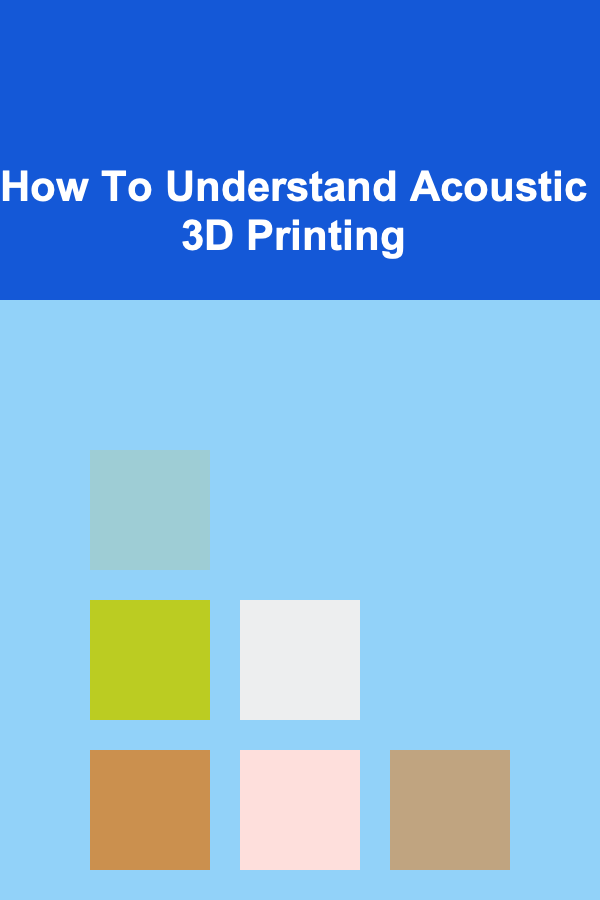
How To Understand Acoustic 3D Printing
ebook include PDF & Audio bundle (Micro Guide)
$12.99$5.99
Limited Time Offer! Order within the next:

Over the past few decades, 3D printing has revolutionized the manufacturing and design industries, enabling the production of complex objects with unmatched precision and efficiency. While traditional 3D printing technologies primarily focus on creating objects by layering materials like plastic, metal, and ceramics, a new and highly intriguing innovation has emerged---acoustic 3D printing. Acoustic 3D printing leverages sound waves to manipulate particles and create structures, presenting a unique intersection between acoustics, engineering, and additive manufacturing.
In this article, we will dive deep into the concept of acoustic 3D printing, exploring its principles, technologies, applications, benefits, and challenges. By the end of this guide, you'll have a comprehensive understanding of this cutting-edge technology and how it can transform various industries.
What is Acoustic 3D Printing?
Acoustic 3D printing, or sound-based 3D printing, is a type of additive manufacturing that uses acoustic waves---specifically, ultrasound or other sound wave frequencies---to manipulate materials in a precise and controlled manner. In this process, sound waves exert pressure on a material, enabling particles or droplets to be moved, positioned, and bound together to form a solid object. The concept is founded on the ability of sound waves to create forces that can precisely control the placement of particles, which is ideal for creating intricate structures and patterns.
Principles of Acoustic 3D Printing
To understand how acoustic 3D printing works, it is essential to first grasp the fundamental principles behind sound waves and their interaction with materials. Sound waves are longitudinal waves that travel through a medium, causing particles within the medium to oscillate. These oscillations produce regions of compression and rarefaction within the medium, creating areas of high and low pressure.
In acoustic 3D printing, these pressure variations are utilized to move and manipulate particles or droplets within a liquid or air medium. Acoustic waves can be directed and controlled with high precision, allowing for fine-tuned control over the deposition of materials and the creation of complex three-dimensional structures. This precision enables the development of new manufacturing techniques and the ability to work with materials that are challenging to handle using traditional methods.
Types of Acoustic 3D Printing Technologies
Acoustic 3D printing is a rapidly evolving field, and various techniques have been developed to leverage sound waves in additive manufacturing. Some of the prominent technologies in acoustic 3D printing include:
1. Ultrasonic 3D Printing
Ultrasonic 3D printing uses high-frequency sound waves (typically in the range of 20 kHz to 1 MHz) to control the motion of particles and droplets within a medium. Ultrasonic waves can generate significant pressure gradients, which can be used to manipulate the particles or liquids suspended within a medium. By adjusting the frequency, amplitude, and phase of the ultrasonic waves, it is possible to fine-tune the movement and deposition of materials, allowing for the creation of intricate and detailed structures.
Ultrasonic 3D printing has gained attention for its ability to work with a wide range of materials, including polymers, ceramics, metals, and even biological substances. The ability to precisely control the position of particles allows for the creation of highly structured and functional objects that would be difficult or impossible to achieve using traditional 3D printing methods.
2. Acoustic Levitation Printing
Acoustic levitation is a technique that uses sound waves to levitate and manipulate small objects, such as particles, droplets, or even larger 3D structures. In the context of acoustic 3D printing, acoustic levitation can be used to position material components in three-dimensional space without direct contact, allowing for the assembly of complex geometries.
This technique works by creating pressure nodes and antinodes within a standing wave. At these nodes, the particles or droplets are trapped and held in place by the sound waves. By manipulating the frequency and amplitude of the sound waves, the levitated particles can be moved and placed with high precision to build a 3D structure.
3. Acoustic Droplet Ejection (ADE)
Acoustic droplet ejection is a specialized technique that uses focused sound waves to eject tiny droplets of liquid from a reservoir onto a substrate. This method allows for the precise deposition of material in the form of droplets, which can then be built up layer by layer to form a three-dimensional object.
ADE is particularly useful for applications requiring high accuracy and control over the volume and placement of droplets. This technique is widely used in inkjet printing and bioengineering applications, where small droplets of ink or biological materials are precisely placed onto a surface to create intricate patterns or structures.
4. Surface Acoustic Wave (SAW) Printing
Surface acoustic wave (SAW) printing uses surface acoustic waves to manipulate particles on the surface of a substrate. These waves propagate along the surface of the material, creating localized pressure variations that can move particles in a controlled manner. SAW-based acoustic 3D printing can be used to assemble particles on a surface or to create intricate patterns of material deposition.
This technology has potential applications in microelectronics, sensor fabrication, and materials science, where precise control over the placement of particles is critical for creating functional devices and structures.
Materials Used in Acoustic 3D Printing
Acoustic 3D printing has the potential to work with a wide variety of materials, both traditional and novel. Some of the key materials used in acoustic 3D printing include:
1. Polymers
Polymers are among the most commonly used materials in acoustic 3D printing. Their versatility, ease of manipulation, and ability to form intricate structures make them ideal for various applications. Polymers can be used in their liquid form (e.g., polymer solutions or suspensions) or in powdered form, depending on the specific technology being employed.
2. Metals
While metals are typically challenging to work with in conventional 3D printing due to their high melting points, acoustic 3D printing allows for the manipulation of metal particles suspended in liquids. This makes it possible to create metal-based structures with high precision, which is particularly useful in fields like aerospace and medical device manufacturing.
3. Ceramics
Ceramics are another material that can be used in acoustic 3D printing. Acoustic waves can be employed to manipulate ceramic powders or suspensions, enabling the creation of highly detailed ceramic components. This is particularly beneficial in industries like electronics and manufacturing, where ceramic parts with precise geometries are required.
4. Biological Materials
In recent years, acoustic 3D printing has shown great promise in the field of biotechnology. Acoustic waves can be used to manipulate biological materials, such as cells, proteins, and DNA, to create bioengineered tissues and organs. This opens up exciting possibilities for medical applications, including tissue engineering and regenerative medicine.
5. Nanomaterials
Nanomaterials, including carbon nanotubes, graphene, and other nanoparticles, are gaining popularity in the field of acoustic 3D printing. The ability to manipulate nanoparticles with acoustic waves offers the potential for creating ultra-precise structures with unique properties, such as enhanced strength, conductivity, and flexibility.
Applications of Acoustic 3D Printing
The versatility of acoustic 3D printing makes it suitable for a wide range of applications across different industries. Some of the key areas where this technology is being explored include:
1. Bioprinting and Tissue Engineering
One of the most promising applications of acoustic 3D printing is in the field of bioprinting. Acoustic waves can be used to manipulate cells, growth factors, and biomaterials with high precision, enabling the creation of complex tissues and organs. This has the potential to revolutionize the field of regenerative medicine, offering new ways to treat diseases and injuries by creating functional tissues and organs in the lab.
2. Microelectronics and Sensors
Acoustic 3D printing is also being used in the fabrication of microelectronic devices and sensors. The ability to precisely position particles and droplets on a substrate allows for the creation of intricate circuits and sensors that are critical for applications in telecommunications, automotive systems, and consumer electronics.
3. Aerospace and Automotive Manufacturing
In aerospace and automotive manufacturing, acoustic 3D printing can be used to create lightweight, complex components with high precision. The ability to work with materials like metal and ceramics opens up new possibilities for the design and production of high-performance parts that are essential in these industries.
4. Nanotechnology and Advanced Materials
The manipulation of nanomaterials using acoustic waves offers significant potential in the field of nanotechnology. Acoustic 3D printing can be used to create nanostructures with enhanced properties, such as increased conductivity, strength, and flexibility. These materials can be used in a variety of applications, including electronics, energy storage, and environmental monitoring.
5. Consumer Products and Customized Manufacturing
Acoustic 3D printing is also being explored for the creation of consumer products, such as customized jewelry, fashion accessories, and home goods. The precision of acoustic 3D printing allows for the production of complex and personalized designs, offering new opportunities for bespoke manufacturing.
Benefits of Acoustic 3D Printing
Acoustic 3D printing offers several unique advantages that make it an attractive option for various industries:
1. Precision and Accuracy
The ability to manipulate particles with sound waves allows for unparalleled precision in the deposition of materials. This makes acoustic 3D printing ideal for applications that require high accuracy, such as bioprinting, microelectronics, and aerospace manufacturing.
2. Non-Contact Manipulation
Unlike traditional 3D printing methods that require direct contact with the material, acoustic 3D printing operates through sound waves, enabling non-contact manipulation of materials. This reduces the risk of contamination and damage, particularly when working with delicate materials like cells or sensitive electronics.
3. Versatility
Acoustic 3D printing is compatible with a wide range of materials, from polymers and metals to biological substances and nanomaterials. This versatility makes it suitable for a broad spectrum of applications across various industries.
4. Reduced Waste
As an additive manufacturing technique, acoustic 3D printing only uses the exact amount of material required to create the object, minimizing waste. This makes it an environmentally friendly option compared to traditional subtractive manufacturing methods, which often produce a significant amount of material waste.
Challenges of Acoustic 3D Printing
Despite its many advantages, acoustic 3D printing is still a developing technology, and there are several challenges that need to be addressed:
1. Limited Material Options
While acoustic 3D printing can work with a variety of materials, the range of materials that can be used is still somewhat limited compared to traditional 3D printing methods. Further research and development are needed to expand the range of materials that can be successfully used in acoustic 3D printing.
2. Complexity and Cost
Acoustic 3D printing technologies can be more complex and expensive to implement compared to traditional 3D printing methods. The equipment required to generate and control the sound waves can be costly, and the technology may require specialized knowledge to operate effectively.
3. Scalability
Scaling acoustic 3D printing to large-scale manufacturing processes presents a significant challenge. While the technology is well-suited for creating small and intricate components, scaling it to mass production levels is still an area of active research.
Conclusion
Acoustic 3D printing represents an exciting frontier in the world of additive manufacturing. By harnessing the power of sound waves, this technology allows for the precise manipulation of materials, offering new possibilities for industries ranging from bioprinting and microelectronics to aerospace and nanotechnology. While there are still challenges to overcome, the potential benefits of acoustic 3D printing make it a promising technology for the future. As research and development continue, we can expect to see even more innovative applications and breakthroughs in this fascinating field.

How to Design a Children's Garden for Learning and Fun
Read More
How to Organize Paint and Stain Supplies for Quick Use
Read More
How to Set Up a Family-Friendly Bathroom Organization System
Read More
How to Sort Holiday Decorations by Category
Read More
How to Update Your Home's Plumbing During a Renovation
Read More
Understanding the Four Cardinal Virtues of Stoicism
Read MoreOther Products

How to Design a Children's Garden for Learning and Fun
Read More
How to Organize Paint and Stain Supplies for Quick Use
Read More
How to Set Up a Family-Friendly Bathroom Organization System
Read More
How to Sort Holiday Decorations by Category
Read More
How to Update Your Home's Plumbing During a Renovation
Read More